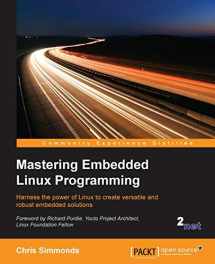
Mastering Embedded Linux Programming
Book details
Summary
Description
Key Features
- Create efficient and secure embedded devices using Linux
- Minimize project costs by using open source tools and programs
- Explore each component technology in depth, using sample implementations as a guide
Mastering Embedded Linux Programming takes you through the product cycle and gives you an in-depth description of the components and options that are available at each stage. You will begin by learning about toolchains, bootloaders, the Linux kernel, and how to configure a root filesystem to create a basic working device. You will then learn how to use the two most commonly used build systems, Buildroot and Yocto, to speed up and simplify the development process. Building on this solid base, the next section considers how to make best use of raw NAND/NOR flash memory and managed flash eMMC chips, including mechanisms for increasing the lifetime of the devices and to perform reliable in-field updates. Next, you need to consider what techniques are best suited to writing applications for your device. We will then see how functions are split between processes and the usage of POSIX threads, which have a big impact on the responsiveness and performance of the final device The closing sections look at the techniques available to developers for profiling and tracing applications and kernel code using perf and ftrace.
What you will learn- Understand the role of the Linux kernel and select an appropriate role for your application
- Use Buildroot and Yocto to create embedded Linux systems quickly and efficiently
- Create customized bootloaders using U-Boot
- Employ perf and ftrace to identify performance bottlenecks
- Understand device trees and make changes to accommodate new hardware on your device
- Write applications that interact with Linux device drivers
- Design and write multi-threaded applications using POSIX threads
- Measure real-time latencies and tune the Linux kernel to minimize them
Chris Simmonds is a software consultant and trainer who lives in southern England. He has been using Linux in embedded systems since the late 1990s, during which he has worked on many interesting projects, including a stereoscopic camera, intelligent weighing scales, various set-top boxes and home routers, and even a large walking robot.
He is a frequent presenter at open source and embedded conferences, including the Embedded Linux Conference, Embedded World, and the Android Builders' Summit. He has been conducting training courses and workshops in embedded Linux since 2002 and in embedded Android since 2010. He has delivered hundreds of sessions to many well-known companies. You can see some of his work on the "Inner Penguin" blog at www.2net.co.uk.
Table of Contents- Starting Out
- Learning About Toolchains
- All About Bootloaders
- Porting and Configuring the Kernel
- Building a Root Filesystem
- Selecting a Build System
- Creating a Storage Strategy
- Introducing Device Drivers
- Starting up - the init Program
- Learning About Processes and Threads
- Managing Memory
- Debugging with GDB
- Profiling and Tracing
- Real-time Programming


We would LOVE it if you could help us and other readers by reviewing the book
Book review



